Managing Employee Behavior: Challenges & Solutions - Essay A3
VerifiedAdded on 2023/06/11
|9
|2228
|499
Essay
AI Summary
This essay explores the challenges managers face in effectively managing employee behavior within organizations, considering factors such as a diversified workforce, changing market trends, manager-employee conflicts, negative employee attitudes, and external influences. It identifies key issues like meeting diverse employee needs, adapting to rapid market changes, resolving conflicts, and addressing negative employee behavior. The essay further proposes several solutions to overcome these challenges, including fostering effective communication, strategic recruitment and selection, promoting positive managerial behaviors, empowering employees, and implementing comprehensive training and development programs. Effective implementation of these strategies is expected to enhance employee behavior and maintain organizational competitiveness.
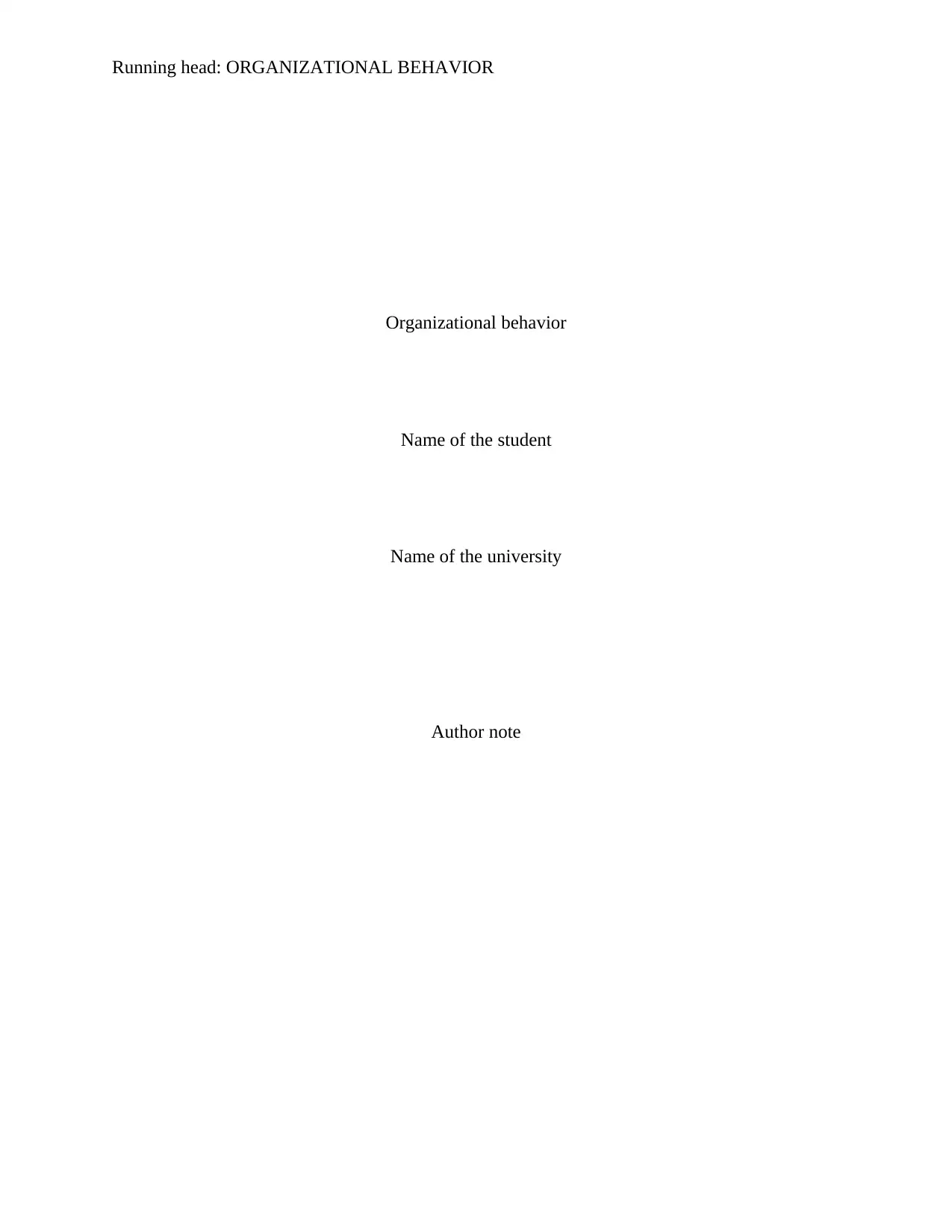
Running head: ORGANIZATIONAL BEHAVIOR
Organizational behavior
Name of the student
Name of the university
Author note
Organizational behavior
Name of the student
Name of the university
Author note
Paraphrase This Document
Need a fresh take? Get an instant paraphrase of this document with our AI Paraphraser
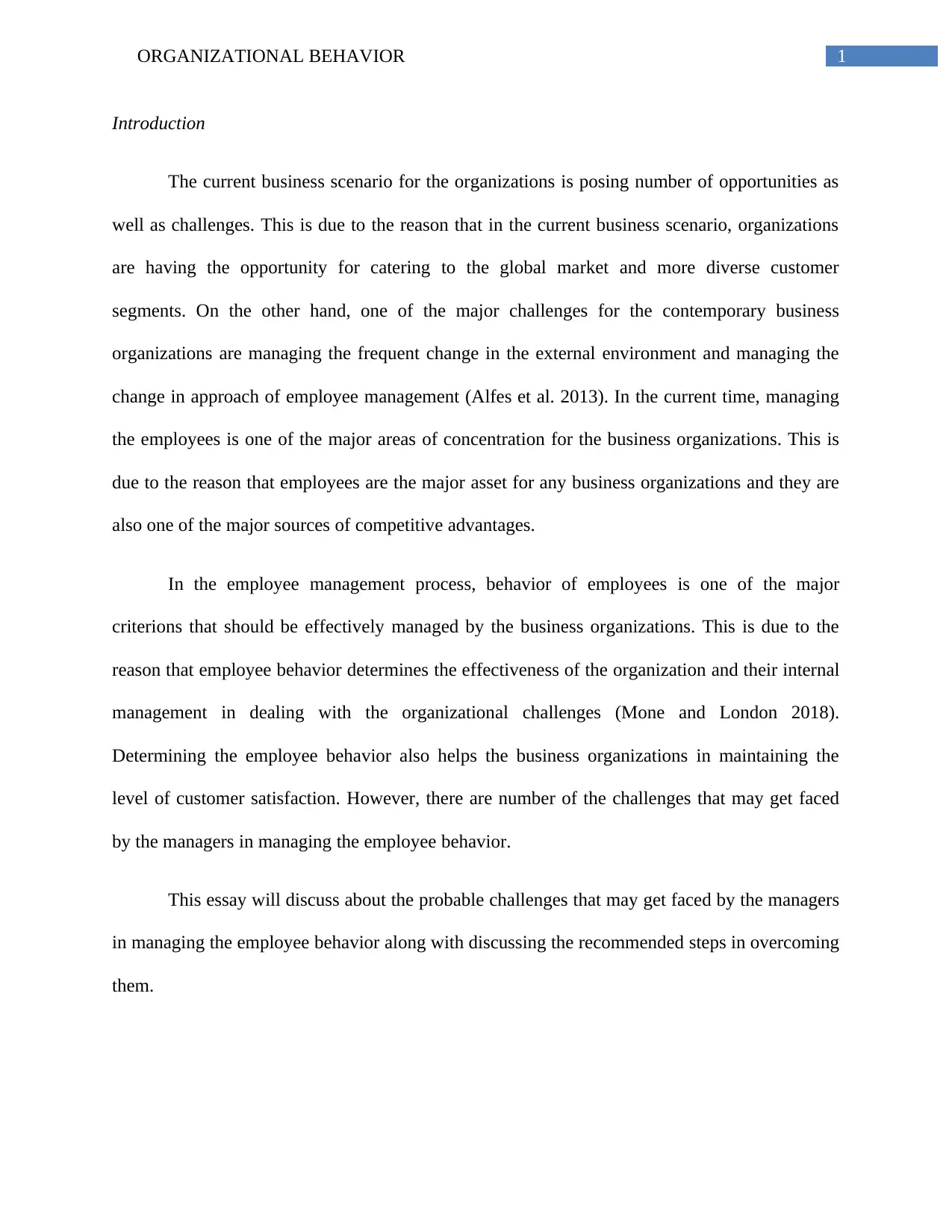
1ORGANIZATIONAL BEHAVIOR
Introduction
The current business scenario for the organizations is posing number of opportunities as
well as challenges. This is due to the reason that in the current business scenario, organizations
are having the opportunity for catering to the global market and more diverse customer
segments. On the other hand, one of the major challenges for the contemporary business
organizations are managing the frequent change in the external environment and managing the
change in approach of employee management (Alfes et al. 2013). In the current time, managing
the employees is one of the major areas of concentration for the business organizations. This is
due to the reason that employees are the major asset for any business organizations and they are
also one of the major sources of competitive advantages.
In the employee management process, behavior of employees is one of the major
criterions that should be effectively managed by the business organizations. This is due to the
reason that employee behavior determines the effectiveness of the organization and their internal
management in dealing with the organizational challenges (Mone and London 2018).
Determining the employee behavior also helps the business organizations in maintaining the
level of customer satisfaction. However, there are number of the challenges that may get faced
by the managers in managing the employee behavior.
This essay will discuss about the probable challenges that may get faced by the managers
in managing the employee behavior along with discussing the recommended steps in overcoming
them.
Introduction
The current business scenario for the organizations is posing number of opportunities as
well as challenges. This is due to the reason that in the current business scenario, organizations
are having the opportunity for catering to the global market and more diverse customer
segments. On the other hand, one of the major challenges for the contemporary business
organizations are managing the frequent change in the external environment and managing the
change in approach of employee management (Alfes et al. 2013). In the current time, managing
the employees is one of the major areas of concentration for the business organizations. This is
due to the reason that employees are the major asset for any business organizations and they are
also one of the major sources of competitive advantages.
In the employee management process, behavior of employees is one of the major
criterions that should be effectively managed by the business organizations. This is due to the
reason that employee behavior determines the effectiveness of the organization and their internal
management in dealing with the organizational challenges (Mone and London 2018).
Determining the employee behavior also helps the business organizations in maintaining the
level of customer satisfaction. However, there are number of the challenges that may get faced
by the managers in managing the employee behavior.
This essay will discuss about the probable challenges that may get faced by the managers
in managing the employee behavior along with discussing the recommended steps in overcoming
them.
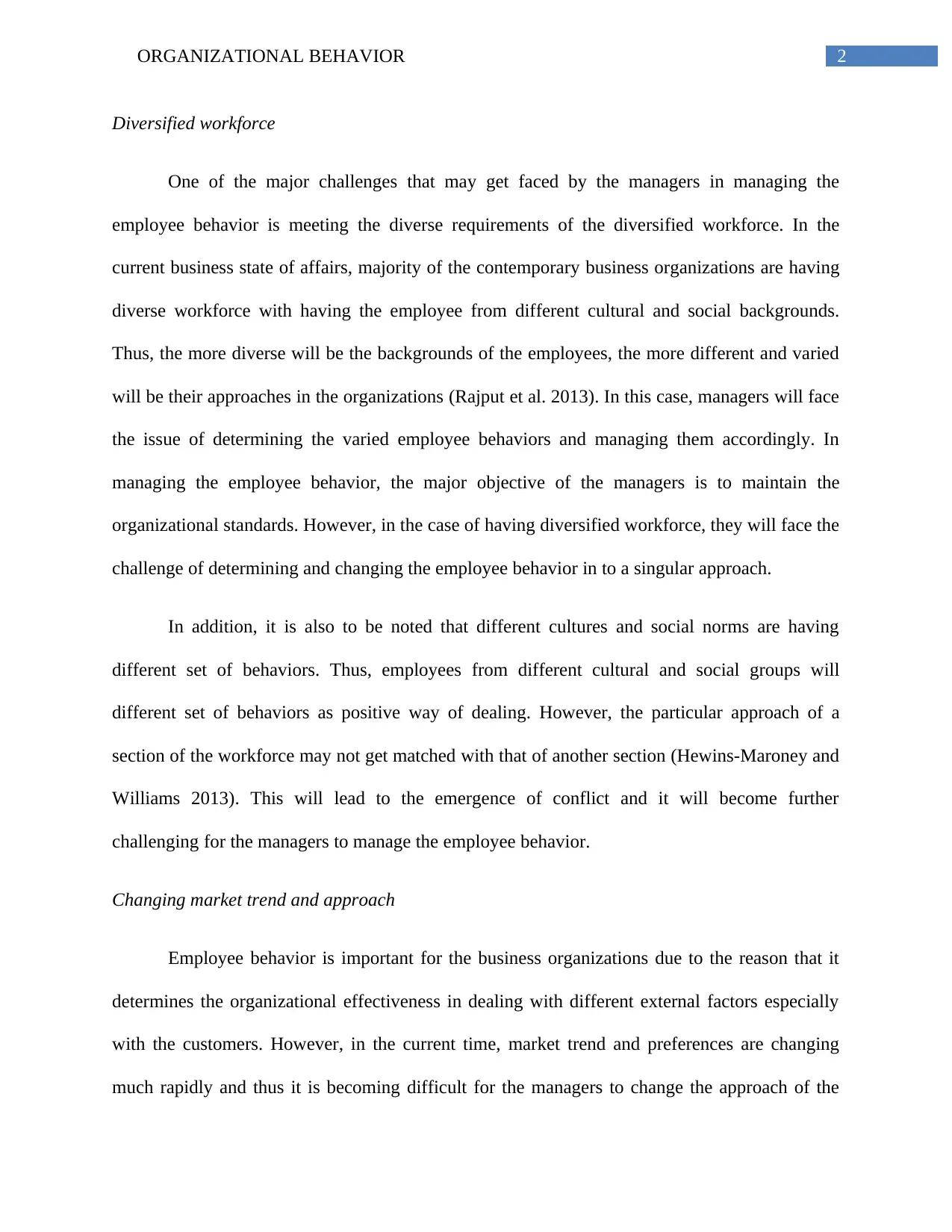
2ORGANIZATIONAL BEHAVIOR
Diversified workforce
One of the major challenges that may get faced by the managers in managing the
employee behavior is meeting the diverse requirements of the diversified workforce. In the
current business state of affairs, majority of the contemporary business organizations are having
diverse workforce with having the employee from different cultural and social backgrounds.
Thus, the more diverse will be the backgrounds of the employees, the more different and varied
will be their approaches in the organizations (Rajput et al. 2013). In this case, managers will face
the issue of determining the varied employee behaviors and managing them accordingly. In
managing the employee behavior, the major objective of the managers is to maintain the
organizational standards. However, in the case of having diversified workforce, they will face the
challenge of determining and changing the employee behavior in to a singular approach.
In addition, it is also to be noted that different cultures and social norms are having
different set of behaviors. Thus, employees from different cultural and social groups will
different set of behaviors as positive way of dealing. However, the particular approach of a
section of the workforce may not get matched with that of another section (Hewins-Maroney and
Williams 2013). This will lead to the emergence of conflict and it will become further
challenging for the managers to manage the employee behavior.
Changing market trend and approach
Employee behavior is important for the business organizations due to the reason that it
determines the organizational effectiveness in dealing with different external factors especially
with the customers. However, in the current time, market trend and preferences are changing
much rapidly and thus it is becoming difficult for the managers to change the approach of the
Diversified workforce
One of the major challenges that may get faced by the managers in managing the
employee behavior is meeting the diverse requirements of the diversified workforce. In the
current business state of affairs, majority of the contemporary business organizations are having
diverse workforce with having the employee from different cultural and social backgrounds.
Thus, the more diverse will be the backgrounds of the employees, the more different and varied
will be their approaches in the organizations (Rajput et al. 2013). In this case, managers will face
the issue of determining the varied employee behaviors and managing them accordingly. In
managing the employee behavior, the major objective of the managers is to maintain the
organizational standards. However, in the case of having diversified workforce, they will face the
challenge of determining and changing the employee behavior in to a singular approach.
In addition, it is also to be noted that different cultures and social norms are having
different set of behaviors. Thus, employees from different cultural and social groups will
different set of behaviors as positive way of dealing. However, the particular approach of a
section of the workforce may not get matched with that of another section (Hewins-Maroney and
Williams 2013). This will lead to the emergence of conflict and it will become further
challenging for the managers to manage the employee behavior.
Changing market trend and approach
Employee behavior is important for the business organizations due to the reason that it
determines the organizational effectiveness in dealing with different external factors especially
with the customers. However, in the current time, market trend and preferences are changing
much rapidly and thus it is becoming difficult for the managers to change the approach of the
⊘ This is a preview!⊘
Do you want full access?
Subscribe today to unlock all pages.

Trusted by 1+ million students worldwide
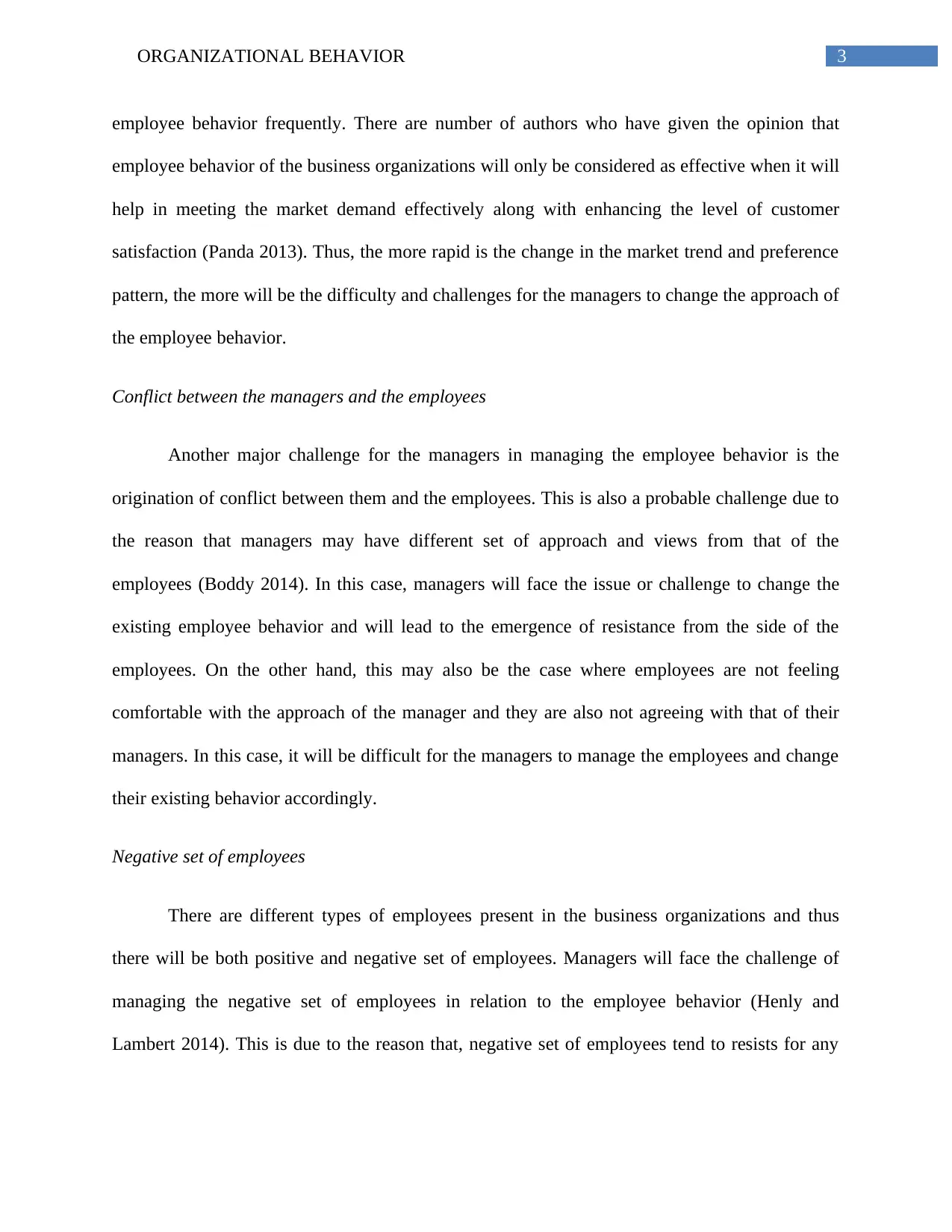
3ORGANIZATIONAL BEHAVIOR
employee behavior frequently. There are number of authors who have given the opinion that
employee behavior of the business organizations will only be considered as effective when it will
help in meeting the market demand effectively along with enhancing the level of customer
satisfaction (Panda 2013). Thus, the more rapid is the change in the market trend and preference
pattern, the more will be the difficulty and challenges for the managers to change the approach of
the employee behavior.
Conflict between the managers and the employees
Another major challenge for the managers in managing the employee behavior is the
origination of conflict between them and the employees. This is also a probable challenge due to
the reason that managers may have different set of approach and views from that of the
employees (Boddy 2014). In this case, managers will face the issue or challenge to change the
existing employee behavior and will lead to the emergence of resistance from the side of the
employees. On the other hand, this may also be the case where employees are not feeling
comfortable with the approach of the manager and they are also not agreeing with that of their
managers. In this case, it will be difficult for the managers to manage the employees and change
their existing behavior accordingly.
Negative set of employees
There are different types of employees present in the business organizations and thus
there will be both positive and negative set of employees. Managers will face the challenge of
managing the negative set of employees in relation to the employee behavior (Henly and
Lambert 2014). This is due to the reason that, negative set of employees tend to resists for any
employee behavior frequently. There are number of authors who have given the opinion that
employee behavior of the business organizations will only be considered as effective when it will
help in meeting the market demand effectively along with enhancing the level of customer
satisfaction (Panda 2013). Thus, the more rapid is the change in the market trend and preference
pattern, the more will be the difficulty and challenges for the managers to change the approach of
the employee behavior.
Conflict between the managers and the employees
Another major challenge for the managers in managing the employee behavior is the
origination of conflict between them and the employees. This is also a probable challenge due to
the reason that managers may have different set of approach and views from that of the
employees (Boddy 2014). In this case, managers will face the issue or challenge to change the
existing employee behavior and will lead to the emergence of resistance from the side of the
employees. On the other hand, this may also be the case where employees are not feeling
comfortable with the approach of the manager and they are also not agreeing with that of their
managers. In this case, it will be difficult for the managers to manage the employees and change
their existing behavior accordingly.
Negative set of employees
There are different types of employees present in the business organizations and thus
there will be both positive and negative set of employees. Managers will face the challenge of
managing the negative set of employees in relation to the employee behavior (Henly and
Lambert 2014). This is due to the reason that, negative set of employees tend to resists for any
Paraphrase This Document
Need a fresh take? Get an instant paraphrase of this document with our AI Paraphraser
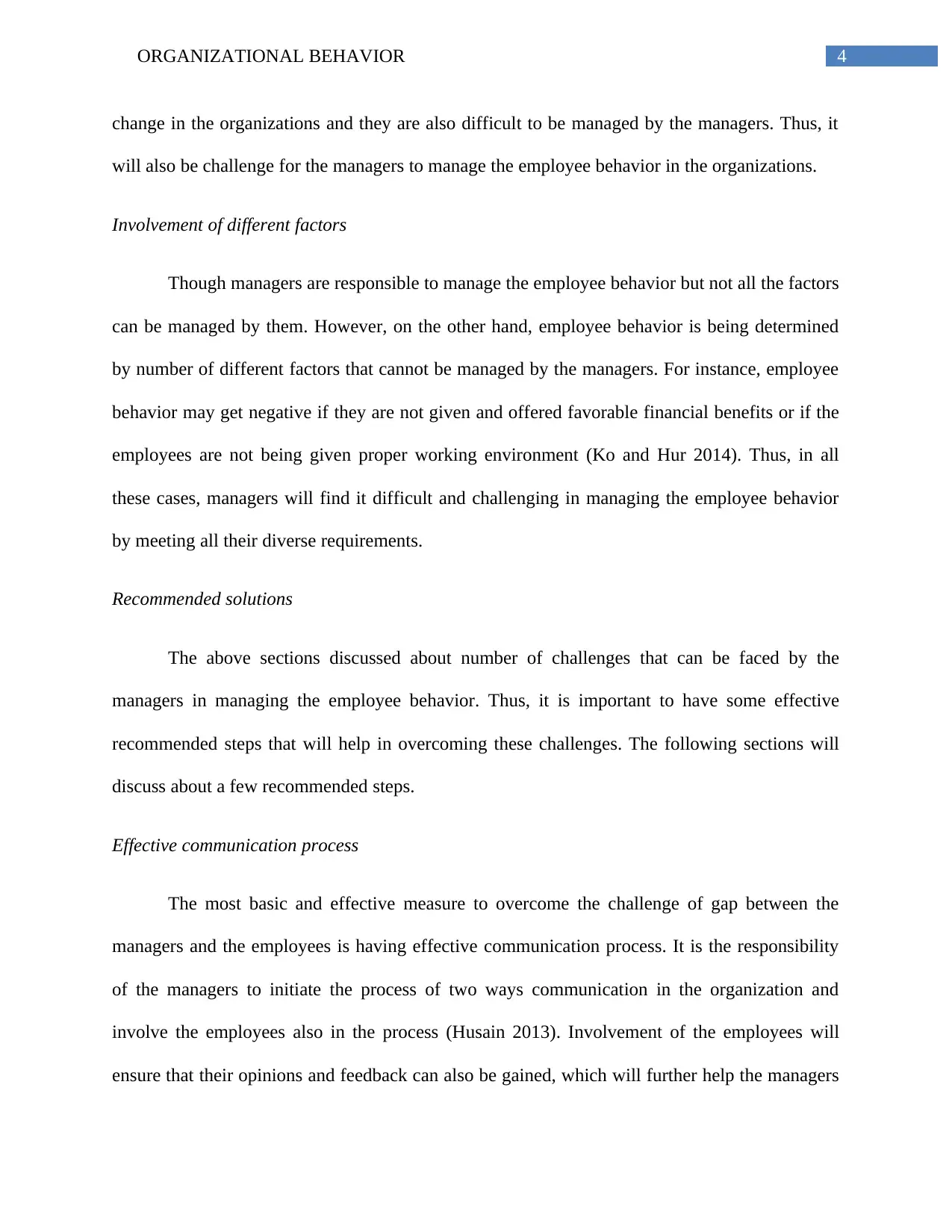
4ORGANIZATIONAL BEHAVIOR
change in the organizations and they are also difficult to be managed by the managers. Thus, it
will also be challenge for the managers to manage the employee behavior in the organizations.
Involvement of different factors
Though managers are responsible to manage the employee behavior but not all the factors
can be managed by them. However, on the other hand, employee behavior is being determined
by number of different factors that cannot be managed by the managers. For instance, employee
behavior may get negative if they are not given and offered favorable financial benefits or if the
employees are not being given proper working environment (Ko and Hur 2014). Thus, in all
these cases, managers will find it difficult and challenging in managing the employee behavior
by meeting all their diverse requirements.
Recommended solutions
The above sections discussed about number of challenges that can be faced by the
managers in managing the employee behavior. Thus, it is important to have some effective
recommended steps that will help in overcoming these challenges. The following sections will
discuss about a few recommended steps.
Effective communication process
The most basic and effective measure to overcome the challenge of gap between the
managers and the employees is having effective communication process. It is the responsibility
of the managers to initiate the process of two ways communication in the organization and
involve the employees also in the process (Husain 2013). Involvement of the employees will
ensure that their opinions and feedback can also be gained, which will further help the managers
change in the organizations and they are also difficult to be managed by the managers. Thus, it
will also be challenge for the managers to manage the employee behavior in the organizations.
Involvement of different factors
Though managers are responsible to manage the employee behavior but not all the factors
can be managed by them. However, on the other hand, employee behavior is being determined
by number of different factors that cannot be managed by the managers. For instance, employee
behavior may get negative if they are not given and offered favorable financial benefits or if the
employees are not being given proper working environment (Ko and Hur 2014). Thus, in all
these cases, managers will find it difficult and challenging in managing the employee behavior
by meeting all their diverse requirements.
Recommended solutions
The above sections discussed about number of challenges that can be faced by the
managers in managing the employee behavior. Thus, it is important to have some effective
recommended steps that will help in overcoming these challenges. The following sections will
discuss about a few recommended steps.
Effective communication process
The most basic and effective measure to overcome the challenge of gap between the
managers and the employees is having effective communication process. It is the responsibility
of the managers to initiate the process of two ways communication in the organization and
involve the employees also in the process (Husain 2013). Involvement of the employees will
ensure that their opinions and feedback can also be gained, which will further help the managers
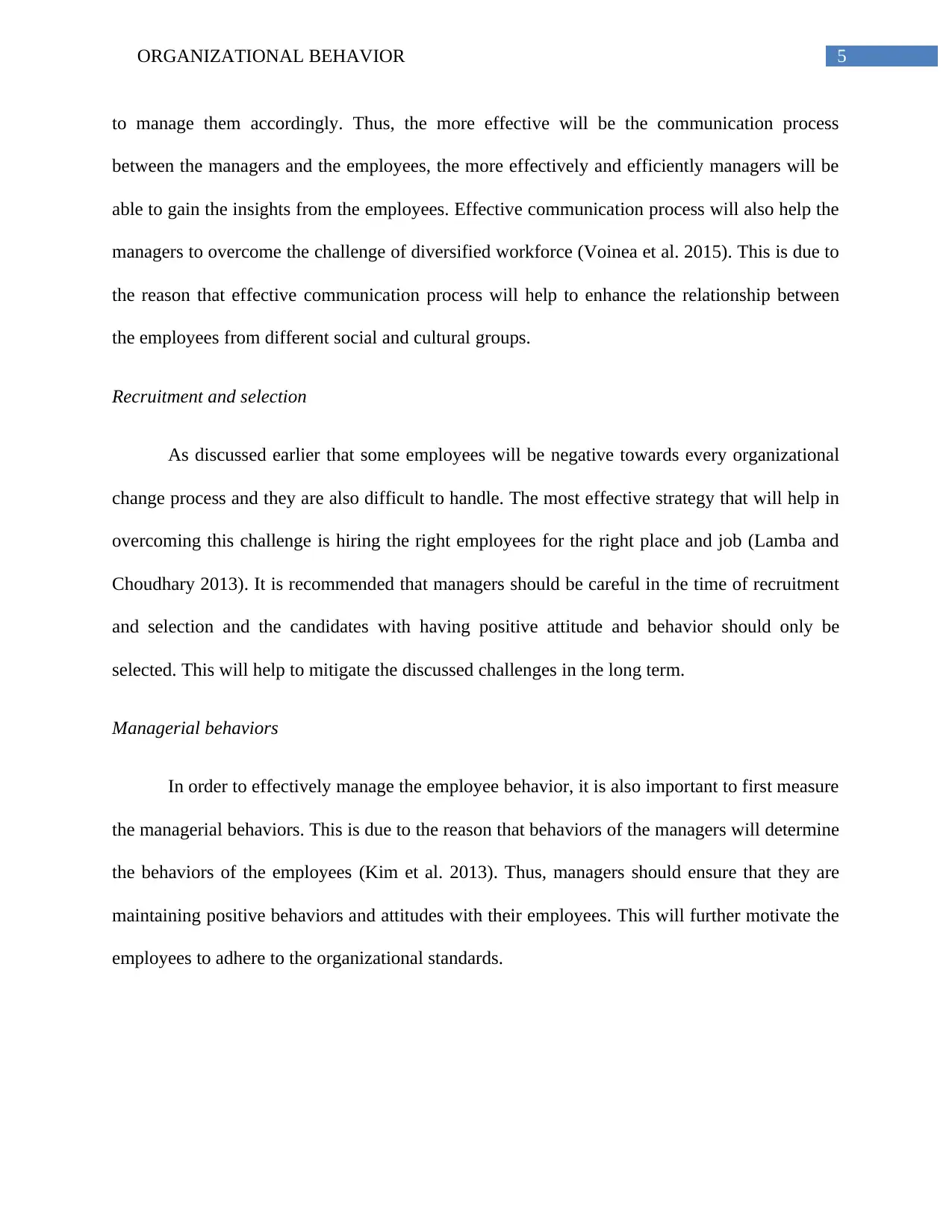
5ORGANIZATIONAL BEHAVIOR
to manage them accordingly. Thus, the more effective will be the communication process
between the managers and the employees, the more effectively and efficiently managers will be
able to gain the insights from the employees. Effective communication process will also help the
managers to overcome the challenge of diversified workforce (Voinea et al. 2015). This is due to
the reason that effective communication process will help to enhance the relationship between
the employees from different social and cultural groups.
Recruitment and selection
As discussed earlier that some employees will be negative towards every organizational
change process and they are also difficult to handle. The most effective strategy that will help in
overcoming this challenge is hiring the right employees for the right place and job (Lamba and
Choudhary 2013). It is recommended that managers should be careful in the time of recruitment
and selection and the candidates with having positive attitude and behavior should only be
selected. This will help to mitigate the discussed challenges in the long term.
Managerial behaviors
In order to effectively manage the employee behavior, it is also important to first measure
the managerial behaviors. This is due to the reason that behaviors of the managers will determine
the behaviors of the employees (Kim et al. 2013). Thus, managers should ensure that they are
maintaining positive behaviors and attitudes with their employees. This will further motivate the
employees to adhere to the organizational standards.
to manage them accordingly. Thus, the more effective will be the communication process
between the managers and the employees, the more effectively and efficiently managers will be
able to gain the insights from the employees. Effective communication process will also help the
managers to overcome the challenge of diversified workforce (Voinea et al. 2015). This is due to
the reason that effective communication process will help to enhance the relationship between
the employees from different social and cultural groups.
Recruitment and selection
As discussed earlier that some employees will be negative towards every organizational
change process and they are also difficult to handle. The most effective strategy that will help in
overcoming this challenge is hiring the right employees for the right place and job (Lamba and
Choudhary 2013). It is recommended that managers should be careful in the time of recruitment
and selection and the candidates with having positive attitude and behavior should only be
selected. This will help to mitigate the discussed challenges in the long term.
Managerial behaviors
In order to effectively manage the employee behavior, it is also important to first measure
the managerial behaviors. This is due to the reason that behaviors of the managers will determine
the behaviors of the employees (Kim et al. 2013). Thus, managers should ensure that they are
maintaining positive behaviors and attitudes with their employees. This will further motivate the
employees to adhere to the organizational standards.
⊘ This is a preview!⊘
Do you want full access?
Subscribe today to unlock all pages.

Trusted by 1+ million students worldwide
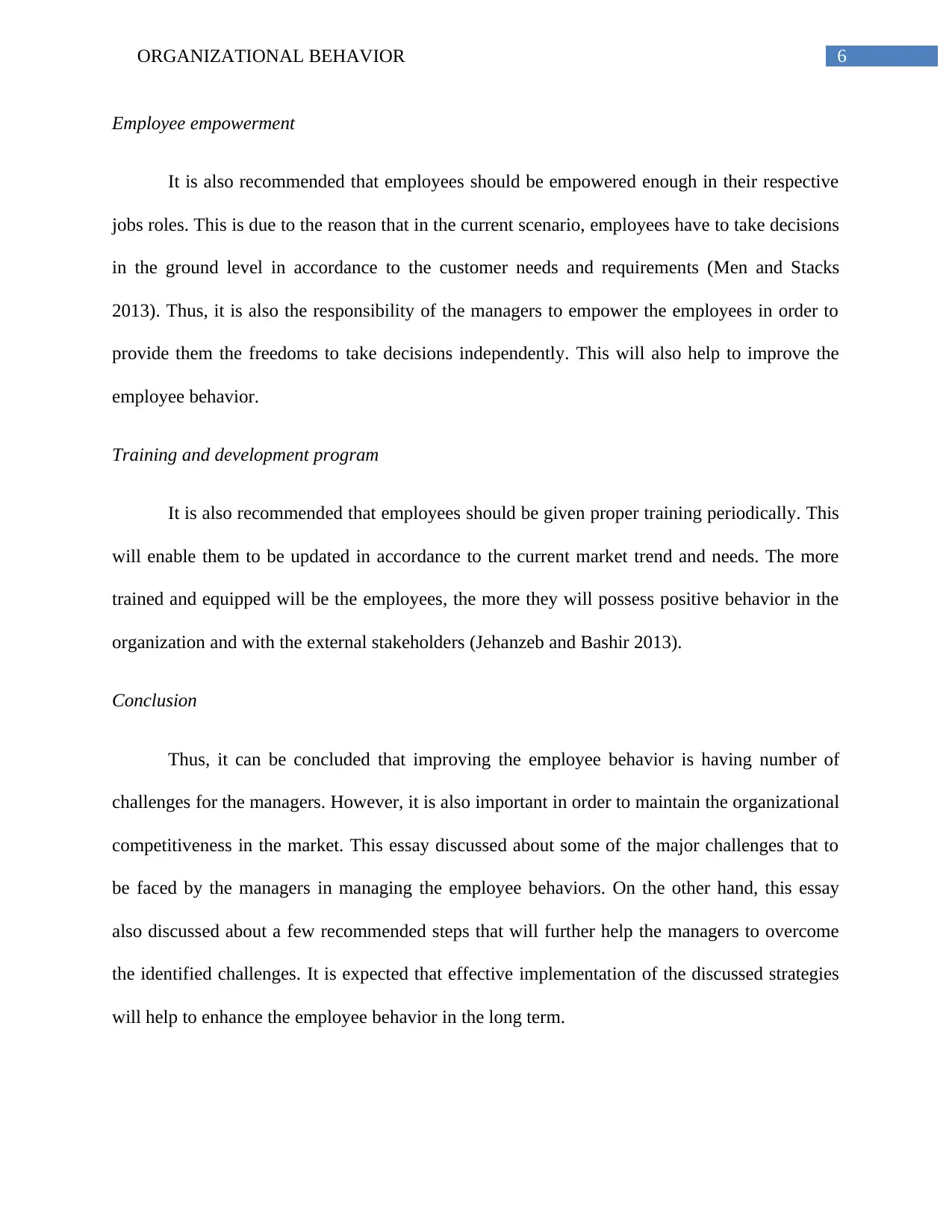
6ORGANIZATIONAL BEHAVIOR
Employee empowerment
It is also recommended that employees should be empowered enough in their respective
jobs roles. This is due to the reason that in the current scenario, employees have to take decisions
in the ground level in accordance to the customer needs and requirements (Men and Stacks
2013). Thus, it is also the responsibility of the managers to empower the employees in order to
provide them the freedoms to take decisions independently. This will also help to improve the
employee behavior.
Training and development program
It is also recommended that employees should be given proper training periodically. This
will enable them to be updated in accordance to the current market trend and needs. The more
trained and equipped will be the employees, the more they will possess positive behavior in the
organization and with the external stakeholders (Jehanzeb and Bashir 2013).
Conclusion
Thus, it can be concluded that improving the employee behavior is having number of
challenges for the managers. However, it is also important in order to maintain the organizational
competitiveness in the market. This essay discussed about some of the major challenges that to
be faced by the managers in managing the employee behaviors. On the other hand, this essay
also discussed about a few recommended steps that will further help the managers to overcome
the identified challenges. It is expected that effective implementation of the discussed strategies
will help to enhance the employee behavior in the long term.
Employee empowerment
It is also recommended that employees should be empowered enough in their respective
jobs roles. This is due to the reason that in the current scenario, employees have to take decisions
in the ground level in accordance to the customer needs and requirements (Men and Stacks
2013). Thus, it is also the responsibility of the managers to empower the employees in order to
provide them the freedoms to take decisions independently. This will also help to improve the
employee behavior.
Training and development program
It is also recommended that employees should be given proper training periodically. This
will enable them to be updated in accordance to the current market trend and needs. The more
trained and equipped will be the employees, the more they will possess positive behavior in the
organization and with the external stakeholders (Jehanzeb and Bashir 2013).
Conclusion
Thus, it can be concluded that improving the employee behavior is having number of
challenges for the managers. However, it is also important in order to maintain the organizational
competitiveness in the market. This essay discussed about some of the major challenges that to
be faced by the managers in managing the employee behaviors. On the other hand, this essay
also discussed about a few recommended steps that will further help the managers to overcome
the identified challenges. It is expected that effective implementation of the discussed strategies
will help to enhance the employee behavior in the long term.
Paraphrase This Document
Need a fresh take? Get an instant paraphrase of this document with our AI Paraphraser
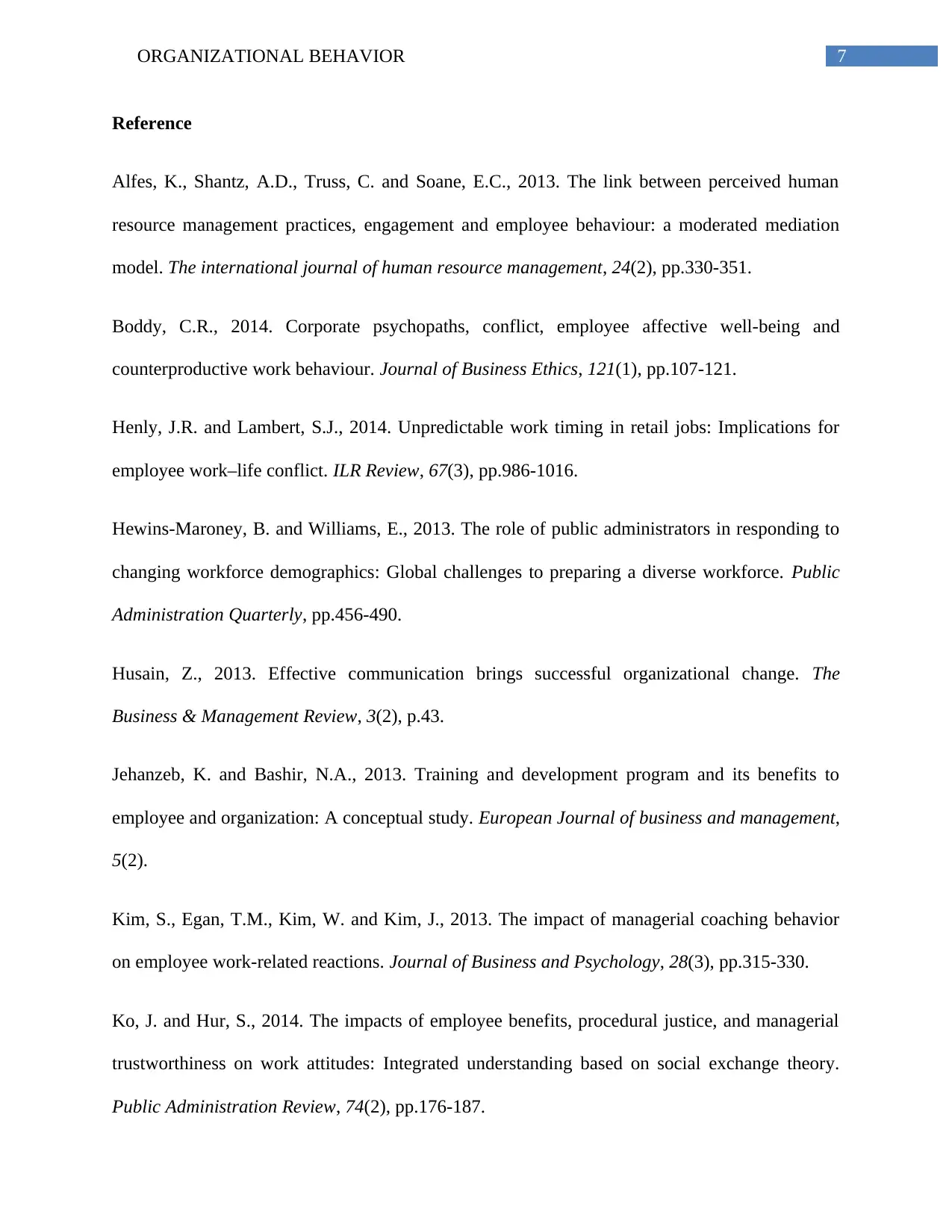
7ORGANIZATIONAL BEHAVIOR
Reference
Alfes, K., Shantz, A.D., Truss, C. and Soane, E.C., 2013. The link between perceived human
resource management practices, engagement and employee behaviour: a moderated mediation
model. The international journal of human resource management, 24(2), pp.330-351.
Boddy, C.R., 2014. Corporate psychopaths, conflict, employee affective well-being and
counterproductive work behaviour. Journal of Business Ethics, 121(1), pp.107-121.
Henly, J.R. and Lambert, S.J., 2014. Unpredictable work timing in retail jobs: Implications for
employee work–life conflict. ILR Review, 67(3), pp.986-1016.
Hewins-Maroney, B. and Williams, E., 2013. The role of public administrators in responding to
changing workforce demographics: Global challenges to preparing a diverse workforce. Public
Administration Quarterly, pp.456-490.
Husain, Z., 2013. Effective communication brings successful organizational change. The
Business & Management Review, 3(2), p.43.
Jehanzeb, K. and Bashir, N.A., 2013. Training and development program and its benefits to
employee and organization: A conceptual study. European Journal of business and management,
5(2).
Kim, S., Egan, T.M., Kim, W. and Kim, J., 2013. The impact of managerial coaching behavior
on employee work-related reactions. Journal of Business and Psychology, 28(3), pp.315-330.
Ko, J. and Hur, S., 2014. The impacts of employee benefits, procedural justice, and managerial
trustworthiness on work attitudes: Integrated understanding based on social exchange theory.
Public Administration Review, 74(2), pp.176-187.
Reference
Alfes, K., Shantz, A.D., Truss, C. and Soane, E.C., 2013. The link between perceived human
resource management practices, engagement and employee behaviour: a moderated mediation
model. The international journal of human resource management, 24(2), pp.330-351.
Boddy, C.R., 2014. Corporate psychopaths, conflict, employee affective well-being and
counterproductive work behaviour. Journal of Business Ethics, 121(1), pp.107-121.
Henly, J.R. and Lambert, S.J., 2014. Unpredictable work timing in retail jobs: Implications for
employee work–life conflict. ILR Review, 67(3), pp.986-1016.
Hewins-Maroney, B. and Williams, E., 2013. The role of public administrators in responding to
changing workforce demographics: Global challenges to preparing a diverse workforce. Public
Administration Quarterly, pp.456-490.
Husain, Z., 2013. Effective communication brings successful organizational change. The
Business & Management Review, 3(2), p.43.
Jehanzeb, K. and Bashir, N.A., 2013. Training and development program and its benefits to
employee and organization: A conceptual study. European Journal of business and management,
5(2).
Kim, S., Egan, T.M., Kim, W. and Kim, J., 2013. The impact of managerial coaching behavior
on employee work-related reactions. Journal of Business and Psychology, 28(3), pp.315-330.
Ko, J. and Hur, S., 2014. The impacts of employee benefits, procedural justice, and managerial
trustworthiness on work attitudes: Integrated understanding based on social exchange theory.
Public Administration Review, 74(2), pp.176-187.
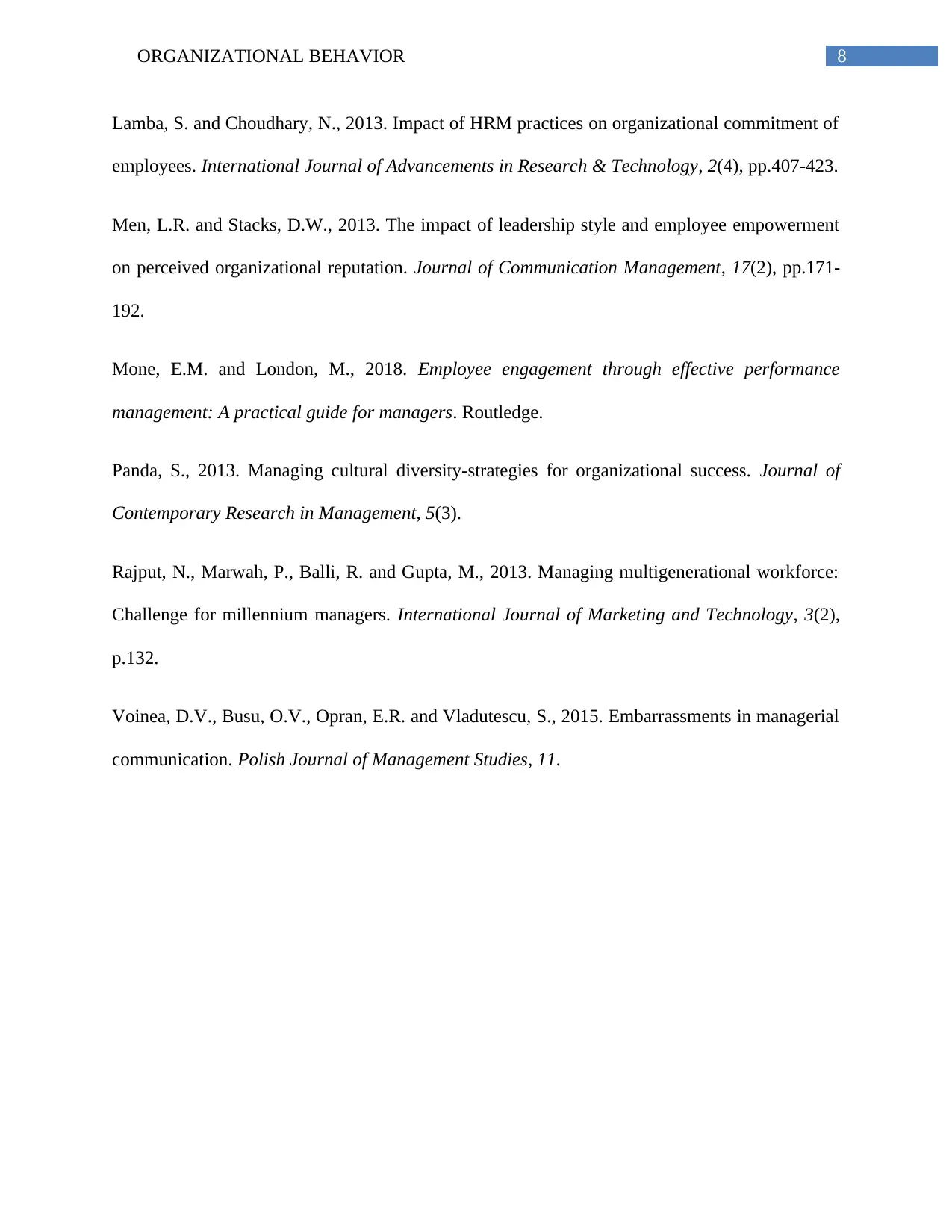
8ORGANIZATIONAL BEHAVIOR
Lamba, S. and Choudhary, N., 2013. Impact of HRM practices on organizational commitment of
employees. International Journal of Advancements in Research & Technology, 2(4), pp.407-423.
Men, L.R. and Stacks, D.W., 2013. The impact of leadership style and employee empowerment
on perceived organizational reputation. Journal of Communication Management, 17(2), pp.171-
192.
Mone, E.M. and London, M., 2018. Employee engagement through effective performance
management: A practical guide for managers. Routledge.
Panda, S., 2013. Managing cultural diversity-strategies for organizational success. Journal of
Contemporary Research in Management, 5(3).
Rajput, N., Marwah, P., Balli, R. and Gupta, M., 2013. Managing multigenerational workforce:
Challenge for millennium managers. International Journal of Marketing and Technology, 3(2),
p.132.
Voinea, D.V., Busu, O.V., Opran, E.R. and Vladutescu, S., 2015. Embarrassments in managerial
communication. Polish Journal of Management Studies, 11.
Lamba, S. and Choudhary, N., 2013. Impact of HRM practices on organizational commitment of
employees. International Journal of Advancements in Research & Technology, 2(4), pp.407-423.
Men, L.R. and Stacks, D.W., 2013. The impact of leadership style and employee empowerment
on perceived organizational reputation. Journal of Communication Management, 17(2), pp.171-
192.
Mone, E.M. and London, M., 2018. Employee engagement through effective performance
management: A practical guide for managers. Routledge.
Panda, S., 2013. Managing cultural diversity-strategies for organizational success. Journal of
Contemporary Research in Management, 5(3).
Rajput, N., Marwah, P., Balli, R. and Gupta, M., 2013. Managing multigenerational workforce:
Challenge for millennium managers. International Journal of Marketing and Technology, 3(2),
p.132.
Voinea, D.V., Busu, O.V., Opran, E.R. and Vladutescu, S., 2015. Embarrassments in managerial
communication. Polish Journal of Management Studies, 11.
⊘ This is a preview!⊘
Do you want full access?
Subscribe today to unlock all pages.

Trusted by 1+ million students worldwide
1 out of 9
Related Documents
Your All-in-One AI-Powered Toolkit for Academic Success.
+13062052269
info@desklib.com
Available 24*7 on WhatsApp / Email
![[object Object]](/_next/static/media/star-bottom.7253800d.svg)
Unlock your academic potential
Copyright © 2020–2025 A2Z Services. All Rights Reserved. Developed and managed by ZUCOL.




